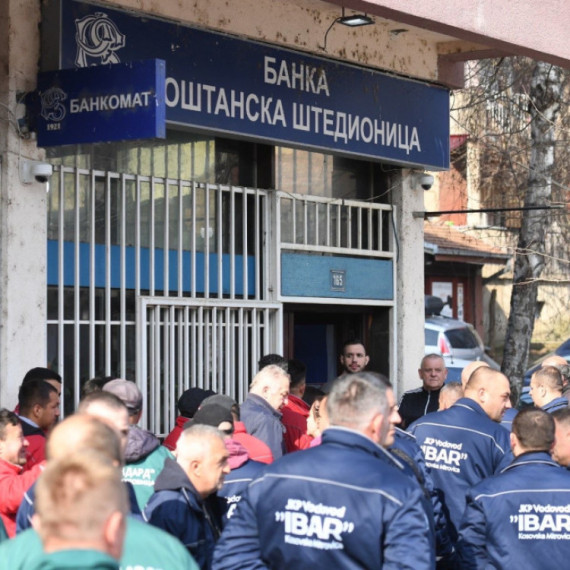Stand up Roma, we shall succeed!
Monday, 22.12.2008.
13:31

Stand up Roma, we shall succeed! No, need to tell you what this is, correct? I believe there are very few – if any – people in Serbia who didn’t rejoice and dance to this song. But I doubt many are aware of the depth of hardship and challenge the nation – whose anthem is Gelem Gelem – faces around Europe and in Serbia. Nobody really knows how many Roma are living in Serbia. But many experts and Roma non-governmental organizations place the Roma population at anything between four to ten percent of the population. Individual Roma have inspired us all but as a community they live in much worse situation than the rest of the population. Roma today can look up for inspiration at Ljiljana Ilic, a graduate of the Faculty of Philology, currently working in the cabinet of the Deputy Prime Minister Bozidar Djelic, or at Petar Antic, Executive Director of the Minority Rights Center, who has a law degree and was a Columbia University scholar. They can identify with Marijan Muratovic, who graduated at the Medical School at the University of Nis and is now studying to get a PHD in molecular biology. As a Roma to be successful, though, is no easy task. I know that data can be tricky in this field, but the shear size of challenge is undeniable. I will use data from a World Bank study, a catalogue of the Fund for an Open Society and Serbian Living Standards Measurement Study. According to both, a staggering 49.2 percent of the Roma population is considered poor in Serbia, compared to 5.4 percent among the general population according to 2007 data. They are not only the poorest ethnic minority, but also represent a sizeable share of extreme poverty: 6.4 percent of Roma are considered extremely poor compared to just 0.1 percent among the general population. And yet more young Roma are seeking a job and working than their peers in the general population. Over 70 percent of Roma aged 15-24 participate in the labor force compared to only 36.4 percent in the general population. While 19.9 percent people ages 15-24 are employed, that number is almost double among Roma of the same age – 36.7 percent of them work at that age. It’s not the same story however once you get older: 65.8 percent of 25-34 olds in Serbia are employed; the equivalent among Roma is 59.3 percent. Moreover Roma generally find themselves in lower paying jobs! However, poverty is not only about jobs. It is multifaceted and is evident in multiple non-income dimensions of deprivation. Education, health, housing, access to public services are also important determinants of poverty. The situation of Roma does not look to good from this angle either. Around 62 percent of the Roma population has not completed primary school; only 9.6 percent attended any school after the primary school, while 50-85 percent of Roma children attend special schools. In comparison to the total population of Serbia, this ethnic group suffers from five time’s greater health problems than the total population of Serbia. Only 6.14 percent of Roma live after the age of 65! I can go on and on describing how dire the situation is. What matters more is what are we doing to change it? In February 2005 heads of government of nine countries, including Serbia, inaugurated in Sofia the Decade of Roma Inclusion. By doing so they committed to pursuing policies aimed at breaking a vicious circle of poverty among the Roma population. In July Serbia took over the Presidency of this Decade. As such Serbia has the unique chance to spearhead policy change at home and abroad as well as shape the debate on a European Roma Policy. Serbia is the first non-EU Member State to lead the Decade. And its presidency comes at a historic time of heightened attention to Roma inclusion across the EU. Unfortunately, things are changing at a very slow rate. I am not saying that nothing is being done, but we appear to be crawling forward at a snail’s pace. Serbia has the capacity to catch up in the next six months. In which direction should we be heading? It is not about designing little projects for Roma here and there. It is also not always only about money, although that is important, too. As Shigeo Katsu, the Vice-President of the World Bank underscored in September at the conference in Brussels, the World Bank’s view is that “real change for the Roma will only materialize once the issue of their exclusion moves from the margins to the center of policy-making”. It is mostly about ensuring that public services and policies work for all citizens – Roma and non-Roma. In education, for example, this involves programs to promote access to integrated schooling for Roma children from kindergarten to beyond compulsory education. Many countries around the world increasingly have begun utilizing conditional cash transfer programs to enhance the motivation for children from marginalized background to school. It also requires rethinking the way the education system is managed and financed to counter the unnecessary segregation of Roma children into low quality schools. The Roma Education Fund has built an impressive knowledge base on good practice and is an asset in advising governments on inclusive education policy. Similar holistic approaches are required to promote employment, sustainable access to health care, and housing policies that counter segregation. What we need now are deeds. An action oriented agenda to realize the commitments of Decade of Roma Inclusion which focuses on promoting policy change. It is important to establish a solid policy coordination forum at the EU level, to bring together policy experts to share experience and best practice from across Europe, both Member States and non Member States. We can use proven instruments, such as the Roma Education Fund, which can serve as a formal knowledge base and technical adviser to governments and European institutions on Roma education policy. Better data collection and monitoring are crucial – we know too little about depth of the challenge of Roma exclusion, and whether government efforts are really making a difference. Certainly we shouldn’t forget that nothing can be done without the involvement of the Roma themselves; without their prominent leaders, their young intellectuals, their vibrant non-government organizations. But it is governments who have to take the lead to break down the barriers between Roma and non-Roma, it is the governments who should send the message: “Come with me, Roma of the world to where the Romani roads have been opened; Now is the time – stand up, Roma, we shall succeed where we make the effort”. Simon Gray is World Bank Country Manager in Serbia Roma Day celebrations in Belgrade (FoNet) Gelem Gelem lungone dromenca, Maladilem chorore romenca. Gelem Gelem lungone dromenca, Maladilem baxtale romenca. Ooo, romalen, Ooo, chavralen. Simon Gray "What we need now are deeds. An action oriented agenda to realize the commitments of Decade of Roma Inclusion which focuses on promoting policy change. It is important to establish a solid policy coordination forum at the EU level."
Stand up Roma, we shall succeed!
No, need to tell you what this is, correct? I believe there are very few – if any – people in Serbia who didn’t rejoice and dance to this song. But I doubt many are aware of the depth of hardship and challenge the nation – whose anthem is Gelem Gelem – faces around Europe and in Serbia.Nobody really knows how many Roma are living in Serbia. But many experts and Roma non-governmental organizations place the Roma population at anything between four to ten percent of the population. Individual Roma have inspired us all but as a community they live in much worse situation than the rest of the population.
Roma today can look up for inspiration at Ljiljana Ilić, a graduate of the Faculty of Philology, currently working in the cabinet of the Deputy Prime Minister Božidar Đelić, or at Petar Antić, Executive Director of the Minority Rights Center, who has a law degree and was a Columbia University scholar. They can identify with Marijan Muratović, who graduated at the Medical School at the University of Niš and is now studying to get a PHD in molecular biology.
As a Roma to be successful, though, is no easy task. I know that data can be tricky in this field, but the shear size of challenge is undeniable. I will use data from a World Bank study, a catalogue of the Fund for an Open Society and Serbian Living Standards Measurement Study. According to both, a staggering 49.2 percent of the Roma population is considered poor in Serbia, compared to 5.4 percent among the general population according to 2007 data. They are not only the poorest ethnic minority, but also represent a sizeable share of extreme poverty: 6.4 percent of Roma are considered extremely poor compared to just 0.1 percent among the general population.
And yet more young Roma are seeking a job and working than their peers in the general population. Over 70 percent of Roma aged 15-24 participate in the labor force compared to only 36.4 percent in the general population. While 19.9 percent people ages 15-24 are employed, that number is almost double among Roma of the same age – 36.7 percent of them work at that age. It’s not the same story however once you get older: 65.8 percent of 25-34 olds in Serbia are employed; the equivalent among Roma is 59.3 percent. Moreover Roma generally find themselves in lower paying jobs!
However, poverty is not only about jobs. It is multifaceted and is evident in multiple non-income dimensions of deprivation. Education, health, housing, access to public services are also important determinants of poverty. The situation of Roma does not look to good from this angle either. Around 62 percent of the Roma population has not completed primary school; only 9.6 percent attended any school after the primary school, while 50-85 percent of Roma children attend special schools. In comparison to the total population of Serbia, this ethnic group suffers from five time’s greater health problems than the total population of Serbia. Only 6.14 percent of Roma live after the age of 65!
I can go on and on describing how dire the situation is. What matters more is what are we doing to change it? In February 2005 heads of government of nine countries, including Serbia, inaugurated in Sofia the Decade of Roma Inclusion. By doing so they committed to pursuing policies aimed at breaking a vicious circle of poverty among the Roma population. In July Serbia took over the Presidency of this Decade.
As such Serbia has the unique chance to spearhead policy change at home and abroad as well as shape the debate on a European Roma Policy. Serbia is the first non-EU Member State to lead the Decade. And its presidency comes at a historic time of heightened attention to Roma inclusion across the EU. Unfortunately, things are changing at a very slow rate. I am not saying that nothing is being done, but we appear to be crawling forward at a snail’s pace. Serbia has the capacity to catch up in the next six months.
In which direction should we be heading? It is not about designing little projects for Roma here and there. It is also not always only about money, although that is important, too. As Shigeo Katsu, the Vice-President of the World Bank underscored in September at the conference in Brussels, the World Bank’s view is that “real change for the Roma will only materialize once the issue of their exclusion moves from the margins to the center of policy-making”. It is mostly about ensuring that public services and policies work for all citizens – Roma and non-Roma.
In education, for example, this involves programs to promote access to integrated schooling for Roma children from kindergarten to beyond compulsory education. Many countries around the world increasingly have begun utilizing conditional cash transfer programs to enhance the motivation for children from marginalized background to school. It also requires rethinking the way the education system is managed and financed to counter the unnecessary segregation of Roma children into low quality schools. The Roma Education Fund has built an impressive knowledge base on good practice and is an asset in advising governments on inclusive education policy.
Similar holistic approaches are required to promote employment, sustainable access to health care, and housing policies that counter segregation.
What we need now are deeds. An action oriented agenda to realize the commitments of Decade of Roma Inclusion which focuses on promoting policy change. It is important to establish a solid policy coordination forum at the EU level, to bring together policy experts to share experience and best practice from across Europe, both Member States and non Member States. We can use proven instruments, such as the Roma Education Fund, which can serve as a formal knowledge base and technical adviser to governments and European institutions on Roma education policy. Better data collection and monitoring are crucial – we know too little about depth of the challenge of Roma exclusion, and whether government efforts are really making a difference.
Certainly we shouldn’t forget that nothing can be done without the involvement of the Roma themselves; without their prominent leaders, their young intellectuals, their vibrant non-government organizations. But it is governments who have to take the lead to break down the barriers between Roma and non-Roma, it is the governments who should send the message: “Come with me, Roma of the world to where the Romani roads have been opened; Now is the time – stand up, Roma, we shall succeed where we make the effort”.
Simon Gray is World Bank Country Manager in Serbia






































Komentari 1
Pogledaj komentare